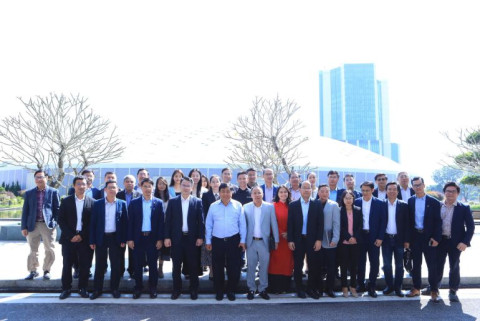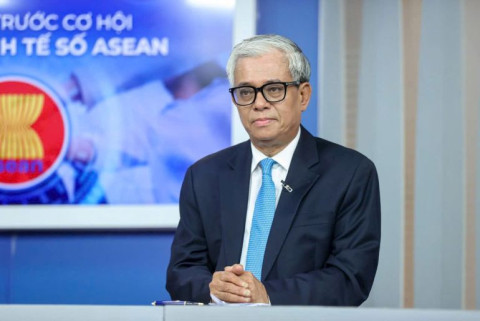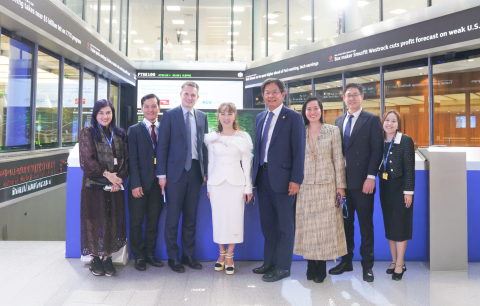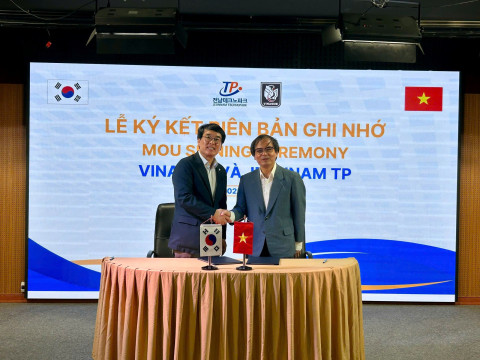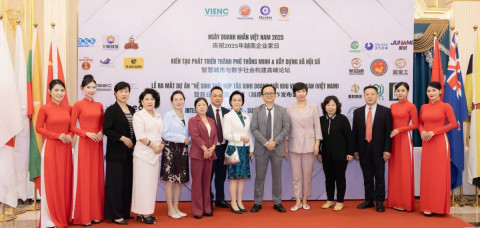Vietnam to Become a Key Link in the Global Semiconductor Value Chain
- 215
- Business
- 20:32 22/02/2024
DNHN - Minister of Planning and Investment Nguyen Chi Dung affirms that Vietnam will become a reliable partner and a key link in the global semiconductor value chain.
The Vietnamese Government has been, is, and will continue to make efforts to prepare the best conditions to welcome investors in the semiconductor industry. In the not-too-distant future, Minister of Planning and Investment Nguyen Chi Dung affirms that Vietnam will become a reliable partner and a key link in the global semiconductor value chain.
To better understand the opportunities opening up for the semiconductor industry as well as the challenges and solutions that need to be implemented to form this high-tech industry, Minister Nguyen Chi Dung shared with Vietnam News Agency reporters on this content.

The Ministry of Planning and Investment has taken the lead in working with the world’s leading enterprises in the field of innovation, calling for investment and cooperation with Vietnam. Can the Minister share the results achieved and the plan for the coming years?
In the past, many large technology companies in the world have cooperated with the National Innovation Centre to implement many innovation programmes and activities, support businesses in digital transformation and train and develop digital human resources such as Google, Meta, Siemens, Hitachi…
In 2023, through the activities of contacting and exchanging delegations at all levels, the Ministry of Planning and Investment has proactively proposed cooperation, calling for investment in the field of innovation with leading enterprises in the world. Through that, many large international enterprises such as John Cockerill, Synopsys, and Cadence have signed cooperation agreements with the National Innovation Centre. This shows that Vietnam is becoming increasingly attractive to technology corporations in the world.
In particular, after important diplomatic achievements, high-level diplomacy, and economic diplomacy, many large enterprises in the world have increased exchanges and cooperation in many economic fields, especially in new industries such as chips, semiconductors, training high-quality human resources…
Based on the achieved cooperation results, the Ministry of Planning and Investment is directing the National Innovation Centre to focus on implementing the cooperation contents agreed upon with current partners and; at the same time, proactively seeking and promoting cooperation with the world’s leading partners in 8 key areas to establish operations at the centre’s operating facilities, especially the facility in Hoa Lac.
This will contribute to strongly promoting growth based more on new driving forces such as the digital economy, science and technology, innovation, new industries and fields such as chips, semiconductors, renewable energy, hydrogen…
The semiconductor industry opens up great opportunities, but according to the Minister, are there any challenges and what are the solutions that need to be implemented to form this high-tech industry?
In the context of the trend of the semiconductor value chain gradually shifting to Southeast Asian countries, Vietnam has all the necessary conditions and factors to develop the semiconductor industry such as a stable political system, a favourable geographical location, an attractive investment incentive mechanism, abundant technical - technological human resources, and increasingly developed digital infrastructure.
The Vietnamese Government is highly determined to pursue and develop the semiconductor industry; it has been and is attracting more and more large corporations in this industry. Many large corporations and enterprises in the electronics and semiconductor industry have been present and are planning to expand investment in Vietnam such as Intel, Samsung, Synopsys, Qualcomm, Infineon, Amkor… This is a testament to the pivotal and increasingly important role of Vietnam in the global semiconductor supply chain.
From 2001 to 2021, the global semiconductor industry grew by 13% each year, reaching 600 billion USD by 2021. The semiconductor industry is expected to continue to grow strongly, reaching 1 trillion USD by 2030 according to research from the Boston Consulting Group (BCG). The world’s largest economies, the US, China, the EU, South Korea and Japan, have all announced subsidy plans for the semiconductor manufacturing industry, creating competition in the global technology industry.
This industry has opened up many opportunities for all countries; including Vietnam, specifically: With the development of new technologies such as artificial intelligence, self-driving cars, Internet of Things (IoT), … are creating a huge demand for semiconductor components. Chip manufacturing can also create great export opportunities, especially when many countries are looking for a safe and independent supply of semiconductors.
However, the semiconductor industry is posing challenges for businesses and governments of countries; which Vietnam is also facing such as high investment costs. The investment level for chip manufacturing is very large, requiring special infrastructure and complex production lines. In practice, building a chip foundry can cost up to 50 billion USD.
International competition is also a challenge when the semiconductor industry is under pressure from high competition, especially from countries such as China, the US and Europe. These countries/regions have announced plans for their chip sector from 50 to 150 billion USD.
Along with that is the challenge of technology, the increasing complexity of semiconductor technology requires large investments in research and development to maintain competitiveness. In particular, the demand for high-quality human resources is very large and in fact, Vietnam’s human resources are still only at the initial stage, with skills and qualifications not yet sufficient to meet the needs of businesses.
The semiconductor industry has appeared in Vietnam since the early 1980s, but we have not had a national development strategy. Therefore, this field in our country is still quite rudimentary, with no deep participation of domestic enterprises, mainly foreign enterprises.
For the semiconductor industry in our country to develop commensurate with its available advantages, the Ministry of Planning and Investment is focusing on the following contents to initially form this high-tech industry; that is: improving the quality of human resources; building a separate mechanism and policy to attract and utilise investment from abroad and investing in building research and development (R&D) centres, thereby creating a favourable environment for Vietnamese researchers and businesses to access new technologies.
The Government has assigned the Ministry of Planning and Investment to develop a Project on developing human resources for the semiconductor industry by 2030, with a specific target of 50,000 semiconductor workers in the coming time. According to the Minister, what needs to be done for this project to be effective?
Vietnam has made correct, important and decisive policies to increase investment attraction in the semiconductor industry; the Government is assigning the Ministry of Planning and Investment to preside over, and coordinate with the Ministry of Information and Communications, the Ministry of Education and Training and related agencies to study and develop a Project on developing human resources for the semiconductor industry, with the goal of training and developing 50,000 human resources for the industry by 2030.
We have very clearly defined the goal of the Project on developing human resources for the semiconductor industry by 2030, which is expected to train a supply of 50,000 engineers in the semiconductor industry, including 15,000 microchip design engineers and 35,000 engineers in other stages with all three levels of bachelor’s, master’s and doctorate degrees. The above figures are based on a survey of the actual needs of businesses in the semiconductor sector in Vietnam and the training capacity of domestic education units.
The project focuses on developing training programmes for lecturers and students; building international standard curricula; postgraduate training and a mechanism to attract domestic talents and international experts; at the same time, implementing international training cooperation programmes to train a team of highly specialised personnel according to international standards; creating an environment for exchange and study abroad; promoting the transfer and learning of advanced technologies.
In addition, encouraging microchip research and development projects; applying and commercialising research projects; and building a research network linking institutes and schools; at the same time, there needs to be close coordination between relevant parties such as the Government, state agencies, private enterprises and research institutes, universities to develop and implement the project.
In particular, it will ensure that the output of future semiconductor human resources is exposed to personnel needs and supports business development through programmes to support engineers working at home and abroad; support start-ups; build an innovation ecosystem; support study exchanges and prioritise the use of products with a high domestic localisation rate.
Finally, it is to build a solid financial mechanism to meet the project’s funding needs based on state budget sources, socialisation, international funding, and legal revenue sources and arrange reasonable funding for training programmes, scholarships and training organisations.
What are the prospects and potential of the semiconductor sector in Vietnam in the coming time? What has the Government and the Ministry of Planning and Investment done to promote cooperation in this field?
In the context of the trend of the semiconductor value chain gradually shifting to Southeast Asian countries, Vietnam has all the necessary conditions and factors to develop the semiconductor industry such as a stable political system, a favourable geographical location, an attractive investment incentive mechanism, abundant technical - technological human resources, and increasingly developed digital infrastructure. The Vietnamese Government is highly determined to pursue and develop the semiconductor industry; it has been and is attracting more and more large corporations in this industry.
The commitment and support of the US President for Vietnam to participate in the global high-tech value chain and in the chip and semiconductor industry has opened up a great opportunity for Vietnam to join the international high-value manufacturing network.
Many large corporations and enterprises in the electronics and semiconductor industry have been present and are planning to expand investment in Vietnam such as Intel, Samsung, Synopsys, Qualcomm, Infineon, Amkor… This is a testament to the pivotal and increasingly important role of Vietnam in the global semiconductor supply chain.
Vietnam has made correct, important and decisive policies to increase investment attraction in this field. Accordingly, Vietnam is building: a national strategy on the semiconductor industry by 2023; a project on developing human resources for the semiconductor industry, with the goal of training and developing 50,000 human resources for the industry by 2030. Recently, the National Assembly also issued a Resolution assigning the Government to develop a Decree to establish a fund to support investment in the high-tech industry, including the semiconductor industry, expected to be issued in mid-2024.
The Government has approved Power Plan VIII and established a National Steering Committee for key projects in the energy sector to provide stable and sustainable electricity to serve investment projects, especially investment projects in the high-tech sector and the semiconductor industry, stepping up site clearance, preparing enough clean land in industrial parks, economic zones, high-tech zones, as well as speeding up the progress of important transport projects connecting to seaports, airports… creating convenience and enhancing the competitiveness of semiconductor projects.
The Vietnamese Government has been, is, and will continue to make efforts to prepare the best conditions to welcome investors in the semiconductor industry. In the not-too-distant future, we believe that Vietnam will become a reliable partner and a key link in the global semiconductor value chain. I hope that investors will come, seek their investment opportunities and contribute to the development of Vietnam.
Thank you very much, Minister!
Thuy Hien
Related news
- Connecting Leaders, Shaping the Future: Strategic Leadership Planning Meeting – CorporateConnections Hanoi A
- Sunlight - Unilever Vietnam Recognized for Outstanding Contributions to the National Initiative Supporting Women Entrepreneurs
- Deputy Prime Minister Nguyễn Chí Dũng: “The country’s major challenges weigh heavily on my mind — and we must resolve them together.
- Unitsky String Technologies signs cooperation agreements with three Vietnamese partners, opening a new direction for smart mobility and sustainable development
- When artists do business – livelihood is no poetry!
- Before the D‑day to abolish flat‑rate tax: Fear of technology and costs leave small traders struggling to adapt
- Vietnamese enterprises at a crossroads: the impact of a potential US–China deal
- "Digital technicians" must not be forgotten if Vietnam aims to meet its strategic goals
- HDBank: Impressive profit growth, leading in profitability and advancing international integration
- TNI King Coffee sued for over VND 5 Billion in unpaid debts
- VINASME and Jeonnam Technopark Sign MOU on technology cooperation, human resource training, and trade promotion
- Vietnamese entrepreneurs strengthen ASEAN connectivity in the digital iIntegration era
- Prime Minister: Vietnam aims to become a regional logistics hub
- Vietnam upgraded to Secondary Emerging Market by FTSE Russell
- Hanoi’s economy grows 7.92% in first nine months of 2025, FDI surges nearly threefold
- Vietnam’s strong gdp growth fails to ease labor market distress
- US tariffs on Brazil propel Vietnam’s pangasius into global spotlight
- VietLeap AI Accelerator launches: A strategic springboard for Vietnam’s AI startups
- CICON expands strategic alliances: A new step forward in Vietnam–Korea business connectivity
- What must Vietnamese enterprises do to maintain their position in the global supply chain?
Đọc thêm Business
Connecting Leaders, Shaping the Future: Strategic Leadership Planning Meeting – CorporateConnections Hanoi A
"Your network is your most powerful flowing asset. It generates value, multiplies opportunities, and accelerates your influence across borders."
Innovative ESG enterprise: Trạm Xe Việt startup proposes solutions to build a green mobility ecosystem
As Vietnam commits to achieving Net Zero by 2050 and tightens emissions standards, the transportation sector faces unprecedented pressure to transform.
Deputy Prime Minister Nguyễn Chí Dũng: “The country’s major challenges weigh heavily on my mind — and we must resolve them together.
On the morning of November 26, 2025, Deputy Prime Minister Nguyễn Chí Dũng chaired a high-level working session at the National Innovation Center (NIC) in Hòa Lạc.
Unitsky String Technologies signs cooperation agreements with three Vietnamese partners, opening a new direction for smart mobility and sustainable development
The signing ceremony took place in Minsk, Belarus, on November 28, 2025.
Before the D‑day to abolish flat‑rate tax: Fear of technology and costs leave small traders struggling to adapt
From 1 January 2026 the flat‑rate tax regime will be abolished. Small business households will be required to declare tax based on actual revenue. MISA supports the transition with technology to help micro‑merchants adapt smoothly and transparently.
Vietnamese enterprises at a crossroads: the impact of a potential US–China deal
As the world closely monitors every shift in US-China relations, emerging signals of a strategic agreement between the two global powers are raising hopes for global economic stability.
HDBank: Impressive profit growth, leading in profitability and advancing international integration
Ho Chi Minh City Development Joint Stock Commercial Bank (HDBank, stock code HDB) announced its consolidated profit before tax for the first 9 months of 2025 reached VND 14,803 billion, marking a 17% increase year-on-year (YoY).
TNI King Coffee sued for over VND 5 Billion in unpaid debts
On October 21, 2025, the People’s Court of District 10 in Ho Chi Minh City officially accepted a civil lawsuit concerning a commercial contract dispute between TKT Vietnam Plastic Packaging Joint Stock Company and TNI King Coffee Co., Ltd.
VINASME and Jeonnam Technopark Sign MOU on technology cooperation, human resource training, and trade promotion
On October 15, 2025, in Hanoi, VINASME and Jeonnam Technopark (Korea) signed an MOU to promote trade, advance technology transfer, and develop human resources between enterprises of both nations.
Vietnamese entrepreneurs strengthen ASEAN connectivity in the digital iIntegration era
On the occasion of Vietnam Entrepreneurs’ Day (October 13), an international event themed “Integration – Innovation – Sustainable Development” was solemnly held in Ho Chi Minh City.




